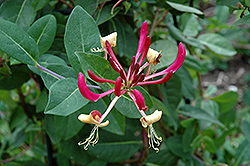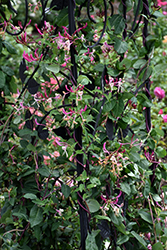Height: 20 feet
Spread: 24 inches
Sunlight:
![]()
![]()
Hardiness Zone: 5a
Other Names: Woodbine Honeysuckle
Description:
Impressive bicolor blooms of pink and white that cover this fast-growing twining vine, followed by a profusion of bright red berries; use to cover eaves and arbors walls; a great plant to attract birds
Ornamental Features
Peaches And Cream Honeysuckle features showy clusters of fragrant shell pink trumpet-shaped flowers with rose overtones at the ends of the branches from late spring to mid summer. It features an abundance of magnificent red berries from mid to late summer. It has green deciduous foliage. The oval leaves do not develop any appreciable fall colour.
Landscape Attributes
Peaches And Cream Honeysuckle is a multi-stemmed deciduous woody vine with a twining and trailing habit of growth. Its average texture blends into the landscape, but can be balanced by one or two finer or coarser trees or shrubs for an effective composition.
This woody vine will require occasional maintenance and upkeep, and is best pruned in late winter once the threat of extreme cold has passed. It is a good choice for attracting butterflies and hummingbirds to your yard. It has no significant negative characteristics.
Peaches And Cream Honeysuckle is recommended for the following landscape applications;
- Mass Planting
- Hedges/Screening
- General Garden Use
- Groundcover
Planting & Growing
Peaches And Cream Honeysuckle will grow to be about 20 feet tall at maturity, with a spread of 24 inches. As a climbing vine, it tends to be leggy near the base and should be underplanted with low-growing facer plants. It should be planted near a fence, trellis or other landscape structure where it can be trained to grow upwards on it, or allowed to trail off a retaining wall or slope. It grows at a medium rate, and under ideal conditions can be expected to live for approximately 20 years.
This woody vine does best in full sun to partial shade. It does best in average to evenly moist conditions, but will not tolerate standing water. It is not particular as to soil type or pH. It is somewhat tolerant of urban pollution. Consider applying a thick mulch around the root zone in winter to protect it in exposed locations or colder microclimates. This is a selection of a native North American species.
Disclaimer - This resource is provided for informational purposes only and does NOT reflect current availability. Inventory varies seasonally, so we cannot guarantee that every plant will be in stock at all times - please contact your favourite GardenWorks location directly for current availability. It does not include our entire inventory of plants, so be sure to visit GardenWorks to see varieties that may not be represented on this list.



